Consistently catching mulloway with live bait is fairly easy once you get your local estuary wired. The hard part is putting all the pieces of the puzzle together.
Live bait consistently produces more mulloway than any other method and although mulloway can be caught year round, Autumn and early Winter is when the action is most consistent on the northern NSW coast.
Large numbers of bream, mullet, tailor and luderick migrate along the coast and spawn in the estuaries, spurring large mulloway to leave their rocky headlands and offshore reefs to enter the estuaries and feed.
In Summer and Spring, the highest tides occur during the mornings but over the cooler months the evening tides are among the highest of the year, approaching 2m. Prolific baitfish (though it’s hard to call a kilo mullet, luderick or tailor a baitfish!) and big night tides create ideal feeding conditions for mulloway in the estuary.
Local lore tags Anzac Day as the start of the mullet run and the estuary mulloway season. Large schools of mullet can be seen like black shadows moving up and down the estuary with the tide and the mulloway are never far behind.
The most and biggest mulloway are generally caught on these chilly nights and their numbers taper off as the migrating fish scatter by September.
Big mulloway are efficient – some would say lazy – predators. An ideal location to find them would have 6m-plus depth, a back-eddy out of strong current, a significant drop-off and abundant supplies of mullet or chopper tailor for them to ambush.
Many top mulloway spots are widely known and a few questions at the local tackle shop will often give you a rough idea where to look but three general scenarios can be easily identified almost every estuary. A boat makes things a lot easier.
The many breakwalls in NSW and South East Queensland adjoin deep water with strong tidal flow, and boulders litter the bottom.
A river entrance often acts as a fish highway and mulloway prefer to sit out of the current behind boulders and ambush baitfish that are swept past.
Breakwall fishing calls for strong tackle and a dependable mate to gaff your fish and help lug tackle and buckets of live bait along the wall.
Breakwalls afford limited fishing time due to the extreme tidal flow but they are easy to locate and consistently produce quality fish.
The major river hole nearest to the sea is often a consistent mulloway spot. Many of these are 10m deep or more.
Recent satellite tracking of estuary mulloway in the Clyde River on the South Coast showed that mulloway use these deep holes for resting and for feeding, and travel from one to another.
These holes are best located and fished from a boat, although many can be accessed from shore. The best holes tend to be flanked by a steep, rocky shore with a substantial drop-off.
On still Winter nights it is possible to see mulloway herding mullet hide up tight to the shore – exciting stuff, especially when your live bait is right in the middle of it!
Bridges that feature deep water, pylons and abundant baitfish are mulloway hot spots. Overhead lighting allows mulloway to ambush baitfish at the edge of the dark water and the lights also are handy when rigging up, playing and landing fish.
The ideal spot to fish a nervous live bait is behind a pylon, out of the current flow. This is where mulloway wait in ambush, but be careful the fish doesn’t wrap you around that same pylon.
On the top of the tide when there is little current, mulloway leave the pylons to hunt and your live bait should be placed just out of the light, where the fish hunt.
Prime time is at high tide after dark.
The sound of a boat engine travels a long distance under water. Mulloway are incredibly shy and boat traffic makes them uncomfortable.
Frequently we have been in the midst of a hot mulloway bite and a boat driving past has shut down everything. High tides late at night, and preferably on weekdays, mean less boat traffic.
It is prudent to slow down 100m from your spot and carefully move to your anchoring site. Moving about with an electric motor is even better.
Be considerate when driving past fishers in boats or on the shore in known mulloway locations; one inconsiderate boat owner can ruin a whole night’s fishing.
While it is possible to catch mulloway on smaller tides, those above 1.4m are more productive because mullet and mulloway can confidently enter the estuary in darkness. These tides occur later at night when there is less boat traffic and the higher tides mean more flow to carry the fish along.
In my early mulloway endeavours, a Saturday night tide of less than 1.4m often meant high tide between 6pm to 8pm. Lots of boats were on the water and I rarely caught anything. However, a Tuesday tide from 10pm to midnight is an opportunity not to be wasted.
Mulloway frequently bite within 30 minutes of the tide change. You should plan to fish the last hour of the run in, the change and the first hour of the ebb. I can plan weeks in advance to fish the best tides. Just remember to factor in the lag time for the high tide the further you fish up river.
Mulloway dislike loud noise and intermittent bright light. I like the dark of the moon because the large tides and pitch black encourage the fish to feed aggressively.
The worse the weather, the better the fishing and I will happily fish in anything up to a 30-knot southerly gale. The fair-weather fisher seldom consistently catches mulloway.
I have caught mulloway on the full moon, but only rarely. The exceptions involve wind, rain and cloud cover. If a decent storm or heavy cloud blocks out moonlight, I will fish with confidence.
Success in consistently catching estuary mulloway can be measured in your ability to catch and keep live mullet and tailor. Herring are only for school jewfish; we need big live baits, ideally a just-legal (30cm) tailor or a mullet of similar size.
Cast nets are illegal in NSW but a drag net and a mate to swim or wade the net out around school of mullet is OK.
But the most popular method is to find a quiet backwater, sand flat or lagoon, berley up mullet with bread and catch them with dough. Use a light threadline outfit with a small quill float, 30cm of 4lb trace running down to a split shot and a size 10 hook.
The bread berley should be moistened enough to make it soggy but not so much that it sinks. If it floats with small particles drifting down, you will attract mullet. If keeps sinking you will be plagued with bream eating all your berley and beating the mullet to your bait.
A live chopper tailor runs a close second. Prime tailor spots are often where you find mulloway, such as bridges with overhead lighting, rock walls, holes and drop-offs.
Depending on how voraciously the bream attack your live baits, for a decent session you will need at least four baits per person and I feel more comfortable with at least six each in the tank.
Baits should be as lively and energetic as possible and should be changed every 30 minutes. They tire out when carrying large hooks and sinkers.
When live bait is scarce, super-fresh dead baits or a lure will still give you a chance. Sometimes the lack of live bait indicates the presence of large numbers of mulloway and then a healthy, kicking livie will be nailed as soon as it hits the water.
You don’t need state-of-the art tackle to catch estuary mulloway. Any reel with a strong drag and 250m of 10kg-15kg line will be fine. I have used a Penn Spinfisher 850SS for years.
I like 15kg mono on all my reels, due to its abrasion resistance and its stretch factor that limits pulled hooks. I think mulloway can feel the angler through the braid and drop a bait, but I know fishos who successfully use it. A 7’ boat rod rated 10kg-15kg or a similar surf rod from the shore is perfect.
I use a size 6-8 ball sinker above 50cm of 23kg fluorocarbon trace with an 8/0 Gamakatsu Octopus hook. I also carry a few star sinkers to use during strong tidal flow.
Remove the sinker at slack water to swim a mullet out on the top of the tide or to lob a live bait into a school of mullet being harassed by mulloway.
When fishing from the bank, an unweighted mullet will attempt to swim back to the safety of the shore, so cast it as far out as possible and slowly wind in the slack as the mullet swims towards you.
The take is often heralded by an increasingly agitated live bait which then quickly seems to grow in size as the mulloway grabs it and heads off.
Mulloway rarely muck around with livies. After years of missing fish through free-spooling, feeding slack line and waiting for the so-called ‘second run’, I now point the rod tip towards the fish as it swims away, then raise the tip to remove the slack and hold on for that first screaming run.
If the bait is in the mulloway’s mouth, so is the hook. Dropping the rod tip towards the fish gives it enough line to start swallowing the bait before driving the hook home.
I recommend every mulloway fisher keep a diary, recording factors such as tide height, moon phase, boat traffic, water clarity, bait, tackle and rigs used and fish numbers caught or lost. This information shows its value only after the first year of consistent and serious fishing, when you can try to emulate your successes of the previous year.
The most important thing is to enter information on every trip, regardless of success. This will allow you to plan future fishing trips for the optimal conditions.
I averaged a mulloway every 15 trips when I started my diary but now I can expect to catch a mulloway every three trips.
Facts
SMALL THINGS COUNT
• Keep light off the water; it scares wary mulloway. A head lamp is invaluable and my favourite is the Energizer Hardcase, which features a red light setting that doesn’t penetrate the water as much.
• Buy the best aerator you can afford. I prefer the Mino-Mizer; it is expensive but extremely long lasting and worth 10 of the cheaper models.
• The feeding window for mulloway is often short, normally 30-45 minutes on a tide change. To maximise fishing time, make up spare rigs and store them in zip-lock bags in your tackle box.
• If you’re a keen catch-and-release fisher like me, plan out the steps to photograph, measure and release a fish as quickly as possible to prevent stress. Buy the biggest landing net you can get your hands on.
• Think of the future. Unfortunately, mulloway are becoming harder to catch in my local Richmond River and their average size is decreasing. I love eating fresh fish but these days I release the majority of my mulloway over 15kg after a quick measure-up and photo, and I encourage other anglers to do the same. NSW Fisheries seems to finally have recognised the overfished state of mulloway and are looking at developing a stricter management plan.
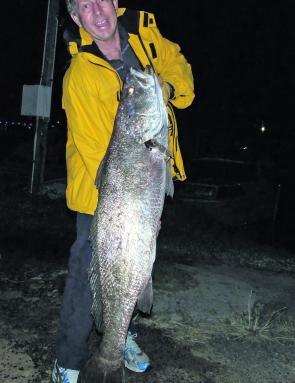
Keith Sloan with 15kg of river mulloway that took a live bait.

All you need to catch a mulloway.

A bait tank with some healthy mullet always helps to inspire confidence.
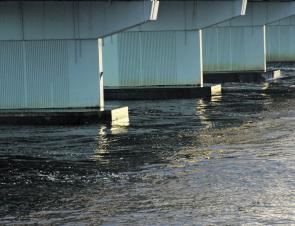
Bridge pylons are prime mulloway habitat. The pressure wave in front of the pylon is a perfect spot to place a live bait.
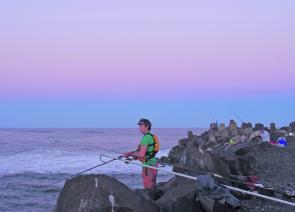
The South Wall at Ballina can get crowded when the mulloway are biting. Daniel Sloan patiently waits with a live tailor out at sunset.
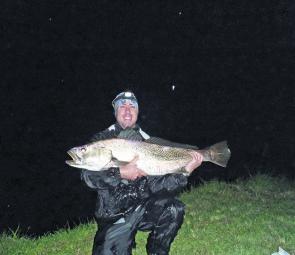
The author with an average-sized Winter specimen.
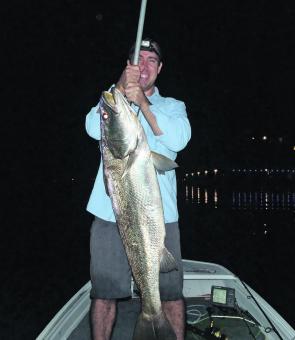
This 15kg fish was gut hooked and destined for the barbecue.
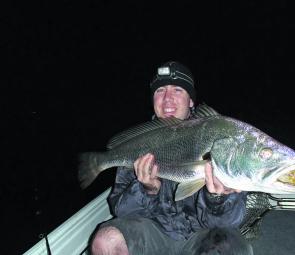
Small things like a warm beanie and headlamp can help make catching fish comfortable and enjoyable.

Jack Van Delft with an excellent winter mulloway destined for release

Even the smallest boat can be a great advantage but sometimes it gets a bit cramped with a decent mulloway on board.
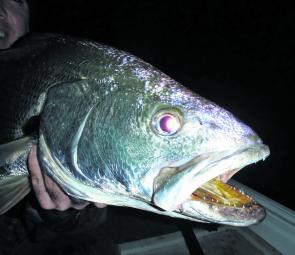
The business end of a mulloway. This is the last thing many terrified baitfish see.
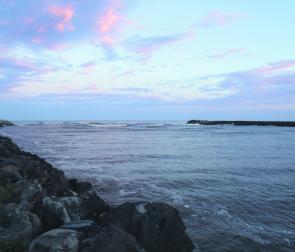
The Ballina Breakwalls at sunset: Prime time and a good spot for big Winter mulloway.
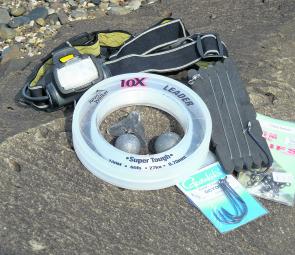
The terminal tackle for mulloway is uncomplicated and relatively inexpensive.




